WHAT'S NEW ACROSS THE WORLD
| What's New ©by
Laif DeMason
The long winter is finally coming to an end. As
the weather slowly improves, it is time to reorganize your cichlid tanks
and give that fish room a good cleaning-out. While you are at it, give
some thought as to how the hobby will fare in the future. There are many
past-time activities competing with the aquarium hobby, and it appears
that fishkeeping may be a bit old-fashioned! Let’s face it, the fishkeeping
hobby could use some new young recruits! It is time for some of us old-timers
to put something back into the hobby. Anyone can help expose young kids
to the wonders of aquarium fishes. What can be a better family-oriented
hobby than one that teaches science, nature, and responsibility. Retailers
and fish clubs alike can team up to sponsor youth-oriented tropical fish
workshops. This can be done through schools, Scouting, or summer camps.
All you need is a good cichlid guy to teach the basics, and a place to
do so. Make sure you schedule a follow-up lesson after a week or two so
the kids can share their experiences and excitement!
Here’s “what’s new” on the cichlid scene: |
Lake Tanganyika
Collections continue at near-normal levels at all points on the Lake.
Exports from Zambia and Tanzania continue to be “multi-national,” with
fishes from different countries arriving in each shipment. Some collectors
in search of new material are sampling the “in-between” sites (those between
the usual, well-known sites), looking for new Tropheus and Opthalmotilapia
varieties. Whether or not these forms will actually prove to be something
new and/or different remains to be seen.
|
what's new: Lake Tanganyika
|

The yellow-tailed Ophthalmotilapia ventralis from
Ulwile Island, Tanzania, is a rarely imported variant of this popular species.
Photo by A. Konings. |

Reportedly from the Gombe area of Zambia, Julidochromis
“transcriptus” has again been imported lately. |
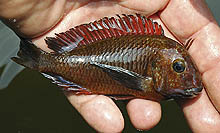
Newly-exported from Zambia, Tropheus moorii Nundo
is collected somewhere between Nkambe and Chilanga (east of Nsumbu).
Photo by T. Veall. |
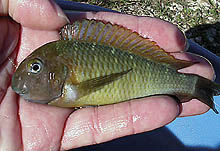
Shipped from Tanzania, this population of T. moorii
Namansi is marked mostly in yellow; very similar to the T. moorii
found near Nangu (Zambia), many miles away! |
Lake Malawi
Collections on the Tanzanian and Malawi coasts continue per normal,
as do exports. However, collections in Mozambique remain spotty,
at best. Some new forms and seasonal items have appeared on the market.
Small mbuna and Aulonocara varieties seem to be holding on to their
current popularity, with large or extra large haplochromines also starting
to become of interest. Captive-bred supplies are also strong and
many Malawi species are available as juveniles.

Captive-bred Metriaclima estherae, or the red
zebra. The “supercharged” color comes from feeding fish food mixed
with 5% commercial Cyclops oil extract. |

Originally collected near Njambe, Tanzania, Metriaclima
sp. “dolphin” is now available as F1 juveniles, but is known to be difficult
to breed. Photo by A. Konings. |

A small new mbuna from Tanzania, Ps. sp. “minutus
tanzania” is infrequently found at Pombo Reef. |

Another new variety from Tanzania, Protomelas
sp. “Chimate” still needs to be properly identified. Any guesses? |
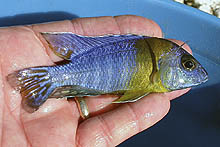
A beautiful male Aulonocara from Gallireya
Reef, Malawi. It is similar to the form collected at Chitimba, known
as Aulonocara Maulana, but the Gallireya Reef form seems to have larger
egg spots. |

A recent arrival from somewhere near Ndumbi, Tanzania,
this form of Pseudotropheus sp. “red top ndumbi” sports red spots
on its forehead, not the usual red blaze. Photo by K. Duelund. |
West Africa
Some new material has appeared from the Congo River areas near Kinshasa
(DR Congo). Other West African countries continue to export their own native
cichlids and other fishes. There is some interest from hobbyists
in finding seasonal or infrequently-collected West African cichlids, year-round.
This may be possible from breeders, but it may prove impossible for importers
to order specialty items on demand.

Juveniles of this rarely-seen Ctenochromis polli
have recently been imported from the Congo. This fish grows to
over five inches in size. Photo by A. Bornstein. |

Imported under the erroneous moniker “Liberia Red,”
this larger form of Pelvicachromis humilis actually comes from Guinea.
Photo, of two males, by A. Bornstein. |
Neotropics
Importers have stepped-up their fish purchasing from most South American
countries. Hobbyists also continue to trek deeper into the bush to collect
that elusive new cichlid, thus increasing the overall number of cichlid
varieties available. General purchases of captive-bred Neotropical selections
have also been strong.

Imported from Peru, Acaronia nassa is found
through Amazonia and is rarely bred in captivity. They are reasonably
peaceful with larger fishes. Photo by J. Rapps. |

Exported in relatively small numbers from Brazil,
Nannacara taenia is also bred in Europe. Photo by O. Lucanus. |
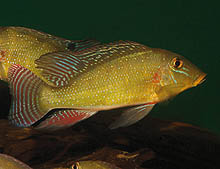
Infrequently available as un-colored juveniles from
southeastern Brazil, Retroculus xinguensis is much more spectacular
as an adult. Photo by O. Lucanus. |
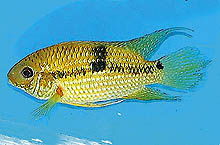
Collected in the Ucayali area of southern Peru, Aequidens
patricki is a relatively peaceful cichlid. Photo by J. Rapps. |
|















